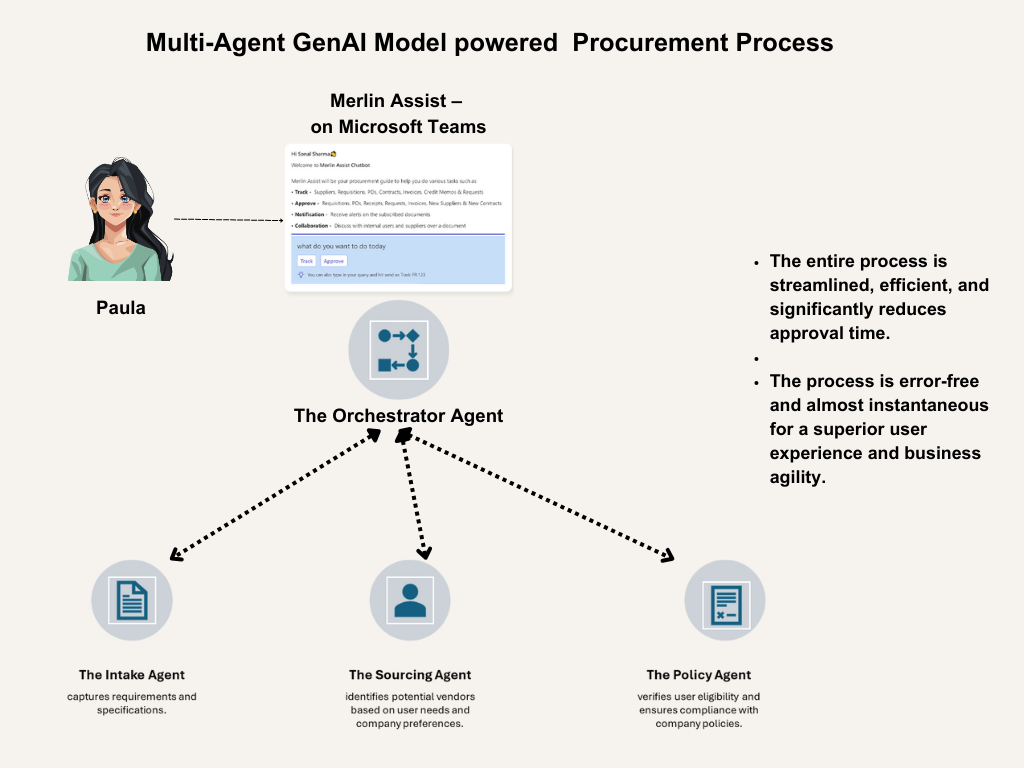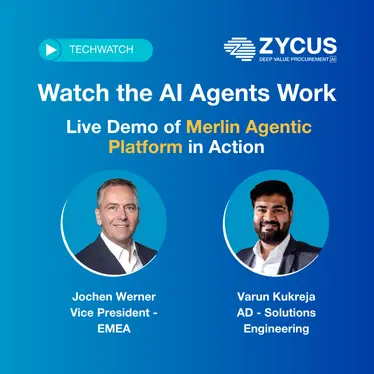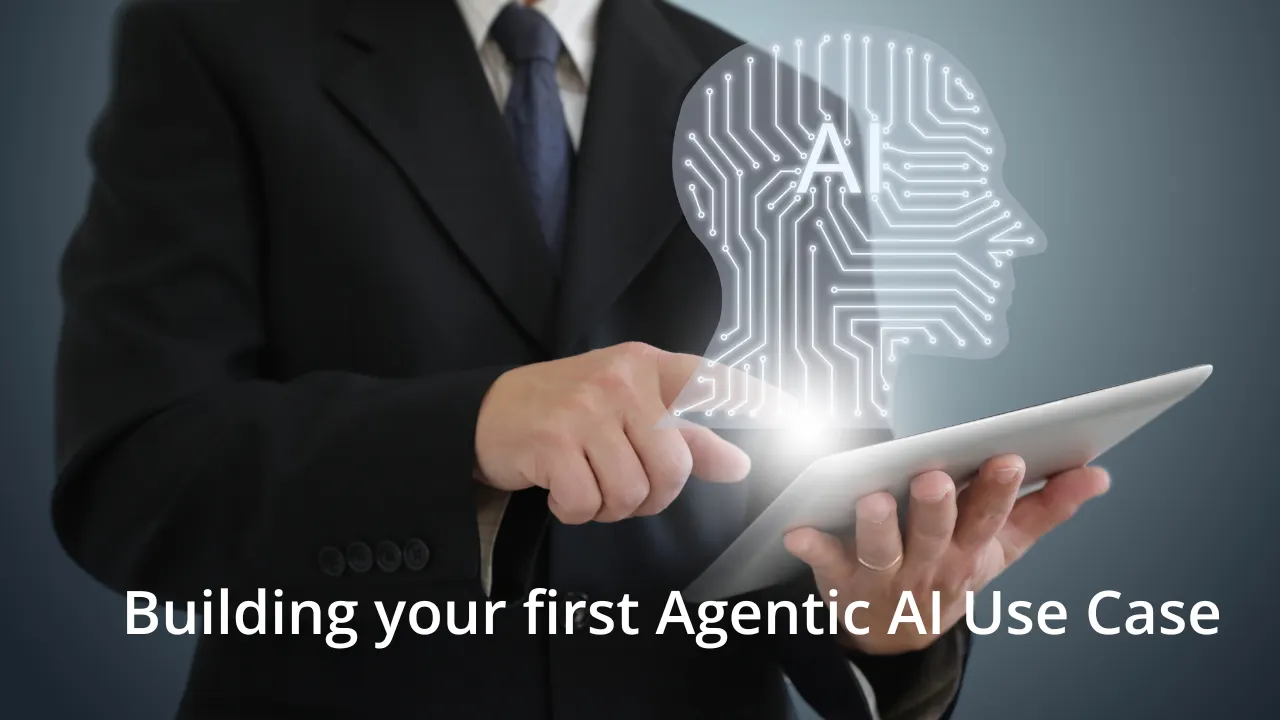Introduction: A Brave New World of Procurement with GenAI
The procurement technology landscape is undergoing a dramatic transformation. Gone are the days of manual, paper-based processes and siloed information. Today, businesses are embracing Generative AI (GenAI) to revolutionize their Source-to-Pay (S2P) processes, driving efficiency, accuracy, and cost savings. A particularly exciting innovation in this realm is the multi-agent GenAI setup, poised to streamline operations and unlock the full potential of AI in procurement.
Are you ready to transform your procurement intake process? Explore the potential of Multi-Agent Generative AI in intake management to automate tasks, improve accuracy, and unlock new levels of efficiency.
Watch Webinar: How Generative AI Can Set Procurement Leaders up for Success
Demystifying the Multi-Agent Setup in GenAI
Imagine a team of highly skilled assistants, each with a specific area of expertise, working together to manage your procurement needs. That’s essentially the essence of a multi-agent GenAI system. It’s a collaborative environment where multiple AI agents, trained on specialized tasks, work in concert to tackle complex procurement workflows. Unlike traditional single-agent systems, which rely on a single AI model to handle everything, multi-agent setups offer several key advantages:
- Distributed Workload and Parallel Processing: Think of it like an assembly line. Each agent tackles a specific task within the procurement process, such as gathering user requirements, searching for qualified vendors, or vetting purchases against company policies. This parallel processing approach significantly reduces overall processing time compared to a single agent tackling everything sequentially.
- Enhanced Scalability: As your procurement needs evolve, a multi-agent system can seamlessly adapt. New agents can be easily integrated to handle additional tasks or domain-specific expertise. This ensures the system remains relevant and grows alongside your business.
- Robustness and Redundancy: Imagine a single point of failure crippling your entire procurement operation. With a multi-agent system, if one agent encounters an issue, the others can continue functioning. This built-in redundancy ensures uninterrupted workflow and mitigates risks associated with reliance on a single AI model. Learn more about built-in intake management component of modern business operations.
- Specialization for Superior Performance: Just like a human expert in a specific field, a multi-agent system allows for specialization. Each agent can be trained on a specific task within the procurement process, leading to superior performance and accuracy in their respective areas.
Read more: A CPO’s Guide to Selecting the Right Multi-Agent GenAI for Procurement
Technical Deep Dive: Single vs. Multi-Agent Architectures
Let’s delve deeper into the technical differences between single-agent and multi-agent GenAI systems. Single-agent systems typically employ a monolithic architecture. This means a single, large AI model is trained on a vast dataset encompassing all aspects of the procurement process. While this approach seems straightforward, it has limitations:
- Complexity Management: Training and maintaining a single model for all tasks becomes increasingly difficult as the complexity of the procurement process grows.
- Limited Scalability: Scaling a monolithic model requires retraining it with additional data, which can be time-consuming and computationally expensive.
- Single Point of Failure: As mentioned earlier, a single point of failure can cripple the entire system.
In contrast, multi-agent systems leverage a modular architecture. Each agent is a smaller, specialized AI model trained on a specific task or domain within procurement. This approach offers several advantages:
- Modular Design: It allows for easier development, maintenance, and updates to individual agents without impacting the entire system.
- Improved Efficiency: By dividing the workload among specialized agents, the system can process tasks much faster than a single-agent model.
- Enhanced Fault Tolerance: If one agent encounters an error, it doesn’t affect the functionality of other agents, ensuring system uptime and uninterrupted workflow.
Example: Single vs. Multi-Agent for Vendor Selection
Consider a scenario where you need to identify potential vendors for a new software purchase.
- Single-Agent System: The single model would need to be trained on a massive dataset encompassing various aspects of vendor selection, including product catalogs, pricing information, historical performance data, and user reviews. This is a complex task, and the model’s accuracy might be limited due to the sheer volume of data involved.
- Multi-Agent System: A dedicated “Sourcing Agent” could be trained to crawl supplier websites and marketplaces, extract relevant information, and identify potential vendors based on user requirements. This agent would work in conjunction with a “Price Comparison Agent” trained to analyze pricing data and negotiate optimal terms.
The Power of Specialization in Multi-Agent Generative AI in Intake Management: A Deep Dive
We’ve established the benefits of specialization in multi-agent GenAI systems. Let’s explore some key agents commonly found in such systems and their roles in the procurement process:
- Intake Management Agent: This agent acts as the primary point of contact for users, interacting with them to capture their purchasing needs and specifications. It uses natural language processing (NLP) capabilities to understand user queries and translate them into actionable.
- Sourcing Agent: This agent takes the baton from the Intake Agent and leverages its expertise in vendor sourcing. It can crawl supplier websites, business directories, and internal databases to find qualified vendors based on the user’s requirements. It can also analyze historical purchasing data and identify preferred vendors based on past performance.
- Policy management Agent: This agent ensures compliance with company procurement policies and regulations. It verifies user eligibility for purchases based on pre-defined rules and approval workflows. It can also analyze potential purchases against budget constraints and raise red flags for any discrepancies.
- Negotiation Agent: This agent can automate price negotiation with vendors based on predefined parameters and historical data. It can utilize advanced algorithms to identify optimal pricing strategies and secure the best possible deals. (Note: Legal and ethical considerations surrounding automated negotiation should be addressed during implementation.)
- Approval Agent: This agent streamlines the approval process by routing requests to the appropriate personnel based on pre-defined workflows. It can also automate notifications and reminders to expedite approvals.
- Risk Assessment Agent: This agent analyzes potential purchases for any associated risks. It can consider factors like vendor reputation, financial stability, and product quality based on historical data and external reports.
Download Whitepaper: Unlocking Deep Value in Intake Management with Merlin Intake
Unveiling the Benefits: How Multi-Agent GenAI Enhances Intake Management Solutions
Let’s delve deeper into the tangible benefits of deploying a multi-agent GenAI system for procurement intake management:
- Reduced Processing Time: Remember the assembly line analogy? Multi-agent systems process tasks in parallel, significantly reducing the time it takes to handle purchase requests compared to traditional, sequential methods. This not only improves efficiency but also enhances user experience by minimizing wait times.
- Increased Accuracy: Each agent in the system is a specialist in its respective domain. This specialization leads to higher accuracy in each stage of the intake process, from capturing user requirements to identifying qualified vendors.
- Improved User Experience: Users interact with a single, user-friendly interface that seamlessly manages their requests behind the scenes. The multi-agent system handles the complexities of the procurement process, freeing the user to focus on their core tasks.
Watch On-demand Webinar: Comprehensive Procurement Orchestration: Leveraging GenAI to Transform Intake Management
Mastering Multi-Agent GenAI: A Hands-On Deep Dive with Tejit Mithal, AVP for Product Management, Zycus
Real-World Scenario: Transforming Intake Management Process with Multi-Agent GenAI
Imagine a company transitioning from a manual intake process to a multi-agent GenAI system. Previously, assume a user, Paula wanted to buy a laptop to replace her laptop which is two years old. Paula would have to submit a purchase request via a digital form or emails. Paula is unsure about many questions being asked on the request form and decides to write NA (not applicable) in some fields just to finish the form quickly.
In other fields she fills what she believes are the most appropriate responses. This form would then get routed to a procurement agent, Jon based out of their regional headquarters. Jon sends back the PR to Paula identifying many discrepancies in the form. This back and forth happens a couple of times before they finally send the PR for further approvals. In parallel, Jon reaches out to the sourcing specialist Mahesh based of their Hyderabad Global Support Center.
Explore Zycus’ Generative AI-Powered Merlin Intake
Mahesh identifies a couple of options for the laptop from their catalog and empaneled vendors. In the meantime, the PR gets rejected by Dana who is the procurement policy expert as it turns out that you can only buy a replacement laptop if your laptop is more than 3 years old. Paula’s laptop was only 2 years old hence if she still wanted to persist, she would have to get an exceptional approval from Regional Head Mathew.
The above process is slow and error-prone process often resulting in delays and inconsistencies. This also creates frustration at all levels – Paula who has to spend so many hours on the PR, forms, chasing up with Jon etc. Jon who believes that he ends up wasting hours teaching every employee how to fill in the request forms accurately. Dana always wonders why employees, including the agents from the procurement team never read the procurement policy.

With the multi-agent GenAI system, users submit their requests through an online portal. The Intake Agent captures their requirements and specifications. The Sourcing Agent identifies potential vendors based on the user’s needs and company preferences. The Policy Agent verifies the user’s eligibility and ensures compliance with company policies. The entire process is streamlined, efficient, and significantly reduces the time it takes to get approvals and move forward with purchases. The process is error free and almost instantaneous giving a far superior user experience and business agility.
Real-World Application: Dow Enhances Procurement Efficiency with AI
In our ongoing exploration of artificial intelligence’s transformative impact, it’s essential to showcase how leading organizations are applying these technologies to streamline their operations. Dow, a global leader in materials science, implemented Zycus’ Merlin AI solution to enhance its procurement efficiency.
Discover how Dow successfully leveraged Zycus’ advanced AI technology to transform its procurement operations and achieve significant efficiency gains. Watch the video below to learn more about their journey and the remarkable improvements they experienced.

Conclusion: A Call to Action for Procurement Leaders
The multi-agent GenAI system isn’t just a technological advancement; it’s a paradigm shift in procurement management. By harnessing the power of specialization and collaboration, these systems offer unparalleled efficiency, accuracy, and improved user experience. Businesses looking to stay ahead of the curve and elevate their procurement operations should seriously consider integrating these innovative solutions.
Don’t get left behind. Explore how GenAI can revolutionize your procurement process and unlock a new era of streamlined efficiency.
Related Reads:
-
- Intelligent Intake Management: Get More Done, Spend Less
- Smart AI Procurement Intake Tools for Success
- 5 Intake Management Best Practices & Strategies
- Watch the Webinar- Revolutionize Procurement with Generative Ai
- eBook- Master the Generative AI Revolution in Procurement
- Beyond the Hype: A CPO’s Guide to Selecting the Right Multi-Agent GenAI for Procurement
- 5 Ways AI is Revolutionizing Purchase Request Processing
- Merlin Intake Resource Hub
- On-Demand Webinar: Transform Intake Management with Zycus Merlin GenAI
- Streamline Procurement Workflows with Efficient Process Orchestration
- On-Demand Webinar: Procurement Orchestration with GenAI-Powered Intake Management
- On-Demand Webinar: Transforming Procurement: GenAI Intake Management Demo
- Whitepaper: Deep Value in Intake Management with Merlin
- Whitepaper: Transforming Procurement: Built-In Intake Management
- Web-stories: Simplify Procurement Intake With Powerful Tools
- Smart AI Procurement Intake Tools for Success





























































